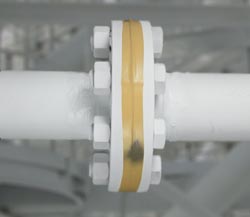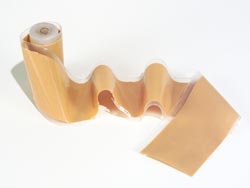
|
|
January 2006 |
FSEC Patent Application Marks Successful Development of New Hydrogen Leak-Detection Compounds Monitoring hydrogen storage and usage sites for leakage is a crucial step in a safe operations plan. To assist NASA in readily discerning the presence of hydrogen leaks, researchers at FSEC have been developing methods for detecting the presence of hydrogen. Since it is such a light gas, diffusing readily, its leakage from a storage tank, in transport or during use can pose potential safety problems. Because hydrogen is also invisible and odorless, developing a system that provides greater ease of use than the currently-employed sensors has been a great challenge. FSEC has filed for a provisional patent before the U.S. Patent and Trademark Office on several formulations dubbed by the researchers as “smart paints for sensing hydrogen gas.” The “smart paints” reveal, in an easy-to-see manner, the presence of hydrogen due to minute gas leaks. Drs. Nahid Mohajeri, Gary Bokerman, Nazim Muradov and Ali T-Raissi have been working on these materials under a grant provided by the NASA-Glenn Research Center. Hydrogen is a propellant used by NASA for launching the Space Shuttle and other space vehicles at Kennedy Space Center.
Unlike natural gas leaks that can be easily detected by their odor, hydrogen leaks are difficult to detect. Operations at NASA facilities require the use of extremely pure hydrogen with no additives to the gas permitted. The FSEC technique provides a visual method to detect and locate possible hydrogen leaks that may occur in the field lines, flanges and joints for hydrogen transport and use. To ensure that hydrogen leaks can be readily detected visually, FSEC researchers, in collaboration with the NASA-KSC colleagues, have been modifying existing formulations and developing new ones to provide easy application and unambiguous results. The “smart paint” can be applied in various forms at pipe connections, valve joints, or other points that may be susceptible to leaks. When there is a hydrogen leak, the paint changes color, alerting technicians to correct the problem. The “smart pigments and paints” have been formulated to change color irreversibly for one time-use, with the color variation remaining even when the hydrogen is no longer present. This system has been field tested at NASA-KSC, and sample kits have been sent to other NASA Centers for evaluation and feedback.
Alternative applications use chemochromic tapes impregnated with the “smart pigment.” FSEC researchers have also developed special tungsten-based pigments that revert to the original color after hydrogen leak has ceased. These special reversible pigments, intended for “repeated use” applications, have been prepared and are currently undergoing field testing at NASA-KSC. Researchers plan to continue development, field testing and weathering assessment of the repeated use and one time-use articles suitable for service in temperatures as low as –359° F. Additionally, efforts will continue toward lowering the overall production costs of the chemochromic materials. For more information on this research, visit: |

